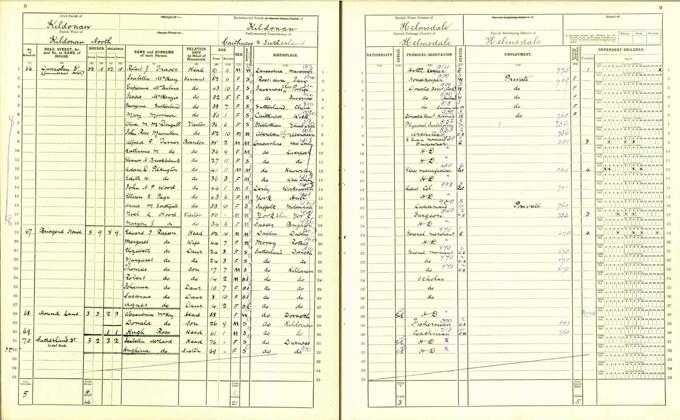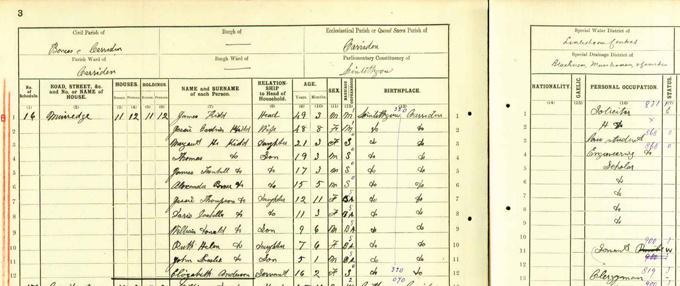The 1921 census records, made up of over 9000 volumes of enumeration district books, have now been released by the National Records of Scotland (NRS) on the online research service Scotland's People. 200,000 images of 4.8 million individual records can now be searched, viewed and downloaded and have been added to the census returns already available on the website, covering every 10 years from 1841.
The census is a survey which collects information on every household, building and vessel in Scotland on a particular night. The enumeration books contain all of the information transcribed from the household schedules (which were destroyed after work on the census was completed) and can be seen online as full colour images.

An example page from the 1921 census enumerating some of the inhabitants of the fishing village of Helmsdale in the parish of Kildonan
Crown copyright, National Records of Scotland (NRS), 1921 census, 052/3 page 9
The 1921 census revealed that the population of Scotland had reached 4,882,500 inhabitants; twice as large as had been recorded in 1831, and three times the size as in 1801. The effects of the First World War (1914-1918) and the influenza pandemic known as ‘Spanish ‘Flu’ (1918) had been felt, however, by local communities and were reflected in the 1921 returns. Between the 1911 and 1921 census the male population had grown by 38,803 and the female population by 82,790, totalling 121,593 individuals or a growth of around 2.5%. This was, however, the smallest increase since 1801 in any census period due to war and emigration.
Over the years, the questions which formed the census have varied, but all are a guide to what the government at the time wanted to know about its population, including its size and age, location, sex and the variety of occupations employing its citizens. Details captured by the census were used to inform government policy at the time; immediately after the census was taken, as is still the case, statistics were made available publicly for demographic purposes. Today, however, these records offer a rich resource of contemporary information which can be explored by historians and genealogists alike in order to trace people, the history of buildings or local areas.
Some questions were removed, changed or added compared to the 1911 census including:
- A question asking whether an individual was ‘Totally Deaf or Deaf and Dumb; Totally Blind; Lunatic; Imbecile or feeble-minded’ was removed
- The number of dependent children under the age of 16 were counted
- A question concerning eligibility for benefit under the National Insurance Act 1911 (a form of protection for working people against loss of income from sickness or unemployment) was introduced
- Orphans living at the address were also surveyed for the first time; the census asked if the father, mother or both parents were deceased.
- For the first time, a question was asked on whether a marriage had been ‘dissolved by Divorce’
The 1921 census detailed changes in occupations, numbers of immigrants and revealed details about the number of orphans and dependent children living in each household. This statistical information has been available for 100 years. However the volumes themselves were closed to protect the details of the people enumerated within them. Today, we can search through the enumerators’ transcriptions of the schedules, scrutinise our ancestors’ personal information and search for famous and influential contemporary names.

Detail from the 1921 census enumerating the Kidd family. The third entry from the top records Margaret H Kidd, a law student. Kidd became the first woman to be called to the Scottish bar (1923), Britain’s first female King’s Counsel (1948) and the first female Sheriff Principal (1960).
Crown copyright, NRS, 1921 census, 663/2/1 page 3
In 1921 the census was scheduled to be taken on 24th April. However, due to industrial unrest it was postponed until Sunday 19th June (as was the case in England and Wales). As a consequence of the summer date, mass displacement of the population occurred as people travelled from their usual residences to holiday destinations across Scotland and the wider UK.
The Registrar General, who had been responsible for organising the census since 1861, noted that the ‘censal population of [a number of] areas was unduly inflated by the presence of summer visitors…especially…those of seaside and other such resorts’ (67th Annual Report of the Registrar-General for Scotland, 1921, page ix). This is something to consider if you cannot find a particular person or family where you think they should be – they may have been on holiday!
The primary legislation for the delivery of the census in Scotland, England and Wales was, and remains today, The Census Act 1920. This dealt with the provision of funds for the census to be undertaken, detailed penalties for those who did not complete it and also allowed for a census to be taken every five years, although this has never come to pass.
For more information about the census records please see our census guide on Scotland's People.